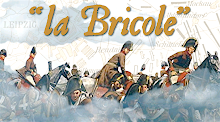Iconic imagery...
"Our Lady of Novodski-Nargil". Every self-respecting Czarist corps needs its Icon and Orthodox Priests to inspire the men.
I've been working on these on and off for a long time now, and have finally finished them. They are the most complex conversions I've done so far, involving a fair amount of epoxy putty and paper clips!
The priest on the left (or is he a monk? I know little about the organization of the Russian Orthodox Church) began life as a Front Rank French Napoleonic line infantry standard bearer, and I replaced the head with that from one of their Seven Year's War Cossacks. I filed down the uniform details on the body, and then slowly built up the robes from epoxy putty. Once the robe was done, I added a fuller beard.
The icon itself is, of all things, the bridge section of a 1/700 Tamiya Fletcher class destroyer (it came with two optional versions). I added plastic card "doors" to the icon and mounted it on a wire pole. It took me some time to do the Virgin and Child!
The venerable gent blessing the troops is a real hodge-podge. The basic skeleton was a Ral Partha ashigaru figure from a fantasy Oriental range. The head was again from a Front Rank SYW Cossack, and I added arms from a Dixon 25mm ACW Union officer! I once more built up the robes from epoxy putty, modified the cap, and added a ZZ-Top-inspired beard. The crucifix was cobbled together from wire and putty, with a chain added from twisted fuse wire.
They were a lot of fun to do, and painting was the biggest challenge as black isn't easy to do convincingly. I used very dark charcoal grey with washes of very, very dark black greens and blues into the folds. The colours didn't come out so clearly with the camera I'm using, so the image was sharpened a fair amount so that the shading would appear a bit more clearly.
I'm now working on a pair of kneeling Russian soldiers modified from some Front Rank casualty figures. When they're done, I'll add them to a plywood base as a little vignette, and post piccies.
I've been working on these on and off for a long time now, and have finally finished them. They are the most complex conversions I've done so far, involving a fair amount of epoxy putty and paper clips!
The priest on the left (or is he a monk? I know little about the organization of the Russian Orthodox Church) began life as a Front Rank French Napoleonic line infantry standard bearer, and I replaced the head with that from one of their Seven Year's War Cossacks. I filed down the uniform details on the body, and then slowly built up the robes from epoxy putty. Once the robe was done, I added a fuller beard.
The icon itself is, of all things, the bridge section of a 1/700 Tamiya Fletcher class destroyer (it came with two optional versions). I added plastic card "doors" to the icon and mounted it on a wire pole. It took me some time to do the Virgin and Child!
The venerable gent blessing the troops is a real hodge-podge. The basic skeleton was a Ral Partha ashigaru figure from a fantasy Oriental range. The head was again from a Front Rank SYW Cossack, and I added arms from a Dixon 25mm ACW Union officer! I once more built up the robes from epoxy putty, modified the cap, and added a ZZ-Top-inspired beard. The crucifix was cobbled together from wire and putty, with a chain added from twisted fuse wire.
They were a lot of fun to do, and painting was the biggest challenge as black isn't easy to do convincingly. I used very dark charcoal grey with washes of very, very dark black greens and blues into the folds. The colours didn't come out so clearly with the camera I'm using, so the image was sharpened a fair amount so that the shading would appear a bit more clearly.
I'm now working on a pair of kneeling Russian soldiers modified from some Front Rank casualty figures. When they're done, I'll add them to a plywood base as a little vignette, and post piccies.
Some mood music- Russian Orthodox choir singing "God Preserve the Czar". A tune which postdates the Napoleonic wars, but which is so synonymous with the 1812 campaign thanks to Tchaikovsky!



















